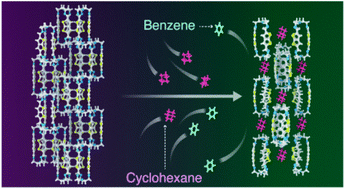Selective adsorptive separation of cyclohexane over benzene using thienothiophene cages†
Abstract
The selective separation of benzene (Bz) and cyclohexane (Cy) is one of the most challenging chemical separations in the petrochemical and oil industries. In this work, we report an environmentally friendly and energy saving approach to separate Cy over Bz using thienothiophene cages (ThT-cages) with adaptive porosity. Interestingly, cyclohexane was readily captured selectively from an equimolar benzene/cyclohexane mixture with a purity of 94%. This high selectivity arises from the C–H⋯S, C–H⋯π and C–H⋯N interactions between Cy and the thienothiophene ligand. Reversible transformation between the nonporous guest-free structure and the host–guest assembly, endows this system with excellent recyclability with minimal energy requirements.



 Please wait while we load your content...
Please wait while we load your content...